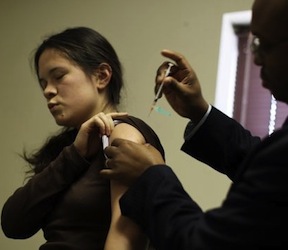
Latinos are less likely to receive the flu vaccine when compared to other ethnic groups, a fact influenced by limited access to medical care, revealed Eduardo Azziz-Baumgartner, a medical epidemiologist with the Influenza Division of the Centers for Disease Control (CDC) in an ABC News report.
The lack of inoculations is particularly concerning, he added, because Latinos are more likely to have pre-existing conditions such as diabetes, which can make the flu more dangerous.
In an effort to reach out to Latino populations during what appears to be a busy flu season, the CDC and a number of other government agencies have begun dispensing information about the flu in Latino communities.
The pamphlets and videos are available in Spanish and offer information on basic influenza facts and the importance of vaccinations.
“This community responds better to messages targeted to protecting the family,” Azziz-Baumgartner said to ABC News. “So if you make an appeal to an individual, such as a working male or female that is not necessarily high risk, this person may be more likely to seek vaccination if we say they’re protecting small children at home or elderly parents at home by being vaccinated.”
According to the Office of Minority Health, the most recent data from 2010 shows 40.6 percent of Latino adults over the age of 18 received the flu vaccine compared to 52.7 percent of non-Hispanic whites. Latino seniors had a slightly higher rate of vaccination at 50.6 percent; however, non-Hispanic white seniors still had a better rate of vaccination at 68.6 percent.
While Latinos lag behind when it comes to flu vaccine, the disparity is a trend which has been occurring for years. In 2009, Hispanic adults over the age of 65 were 30 percent less likely to receive the flu shot compared to non-Hispanic whites within the same age group.
“There is a strong need to educate the Hispanic community on the importance of influenza immunization for the entire family,” Luis Rodriguez, MD, Associate Professor of Pediatrics, NYU School of Medicine, speaking on behalf of the American Lung Association, told Hispanically Speaking News in 2011 interview. “Getting vaccinated each year is the best way to help protect yourself and your loved ones from influenza and its complications.”
Liliana Osorio from the Health Initiative of the Americas, UC Berkeley, School of Public Health, indicates there are a number of reasons contributing to a lack of medical care access for Latinos which create the vaccination disparity.
According to a presentation from Osorio, Latinos have a high acceptance of vaccinations; however, they must overcome barriers to care such as immigration status fear, language barriers, frequent mobility, lack of sick leave at work, transportation, lack of insurance, cost of care, misconceptions about vaccinations, and missed opportunities for vaccination due to a lack of communication from medical providers.
Osorio recommends for Latino flu outreach programs to be successful, several areas must be addressed, including: better relationship building between community-based organizations and public health authorities; tailored communications to deliver culturally, linguistically, and educationally appropriate information; and creating messages which are relevant to the concerns of the Latino population.
This article originally appeared on Voxxi.

Recent Comments